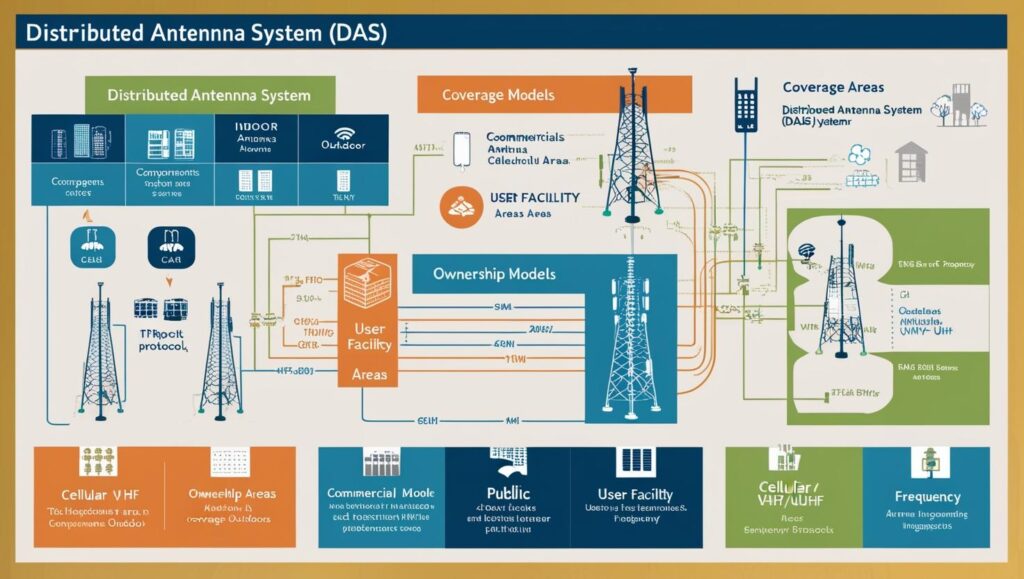The United States Distributed Antenna Systems (DAS) market is on the cusp of an exciting growth phase, driven by the nationwide 5G rollout and the increasing demand for reliable, high-speed wireless connectivity. As industries and consumers alike seek seamless mobile experiences, DAS is emerging as a vital technology for boosting network coverage, improving data speeds, and ensuring connectivity in both indoor and outdoor environments. From smart cities and large venues to enterprise buildings and public infrastructure, DAS plays a pivotal role in shaping the future of wireless communication in the U.S.
The key drivers behind the growing adoption of DAS solutions, the role of 5G in accelerating the market’s expansion, and the future outlook of the U.S. DAS market.
What Are Distributed Antenna Systems (DAS)?
A Distributed Antenna System (DAS) is a network of spatially separated antennas connected to a common source, designed to improve wireless network coverage and capacity within a specific area. Unlike traditional cellular systems, which rely on large, high-powered towers, DAS allows for a more localized, reliable, and efficient signal distribution across a variety of environments. These systems are especially useful in environments where traditional network signals might struggle to penetrate, such as inside large buildings, stadiums, underground areas, and dense urban spaces.
DAS typically operates through fiber-optic cables that carry signals from a central source to various antennas placed throughout the area. This architecture helps extend the reach and capacity of wireless networks, ensuring that high-speed mobile data services, including voice, 4G LTE, and 5G, are accessible throughout the coverage area.

5G Rollout: The Key Catalyst for DAS Market Growth
The imminent 5G rollout is one of the biggest factors driving the expansion of the U.S. DAS market. 5G promises to revolutionize mobile connectivity, offering speeds up to 100 times faster than current 4G LTE networks, ultra-low latency, and the capacity to support massive Internet of Things (IoT) devices. However, to fully realize the potential of 5G, network coverage and density need to be significantly enhanced, particularly in urban environments and densely populated spaces.
Traditional cell towers are not sufficient to meet the demands of 5G, particularly due to the high-frequency spectrum used by 5G signals, which has a shorter range and is more prone to interference. This is where Distributed Antenna Systems (DAS) come in.
DAS offers a scalable solution that can handle the dense bandwidth requirements of 5G networks, allowing for faster, more efficient distribution of signals within buildings, stadiums, airports, shopping centers, and even city streets. With 5G capable of supporting a vast number of connected devices and delivering high-speed data for everything from autonomous vehicles to smart cities, DAS systems will become an indispensable part of the infrastructure needed to support these emerging technologies.
Key Drivers for DAS Adoption in the U.S.
Several factors are accelerating the adoption of DAS solutions across the U.S., including the growing demand for reliable wireless connectivity, urbanization, and the increasing need for seamless mobile experiences. These drivers are also enabling the DAS market to evolve rapidly in response to technological shifts.
1. Increased Demand for Seamless Connectivity
The surge in mobile data consumption, driven by the proliferation of smartphones, tablets, and IoT devices, is putting immense pressure on existing wireless networks. Consumers and businesses alike are demanding reliable connectivity, both indoors and outdoors, at high speeds and with minimal interruptions. DAS systems help meet these demands by extending coverage in areas where network signals are weak or spotty.
From smartphones to virtual reality (VR) and augmented reality (AR) applications, today’s mobile technologies require low-latency, high-bandwidth networks to function effectively. In high-traffic locations like airports, shopping malls, sports arenas, and convention centers, DAS ensures that users experience fast, uninterrupted service, even during peak hours.
2. The Rise of Smart Cities
As cities across the U.S. transition toward smart city solutions, there is a growing need for advanced wireless infrastructure. DAS systems are being implemented to support the growing volume of data generated by connected devices within urban environments. Smart city initiatives rely heavily on real-time data to optimize everything from traffic management and public safety to energy efficiency and public transportation systems.
By providing reliable, high-speed wireless coverage, DAS enables cities to deploy and support a wide range of IoT devices and sensors, enhancing the city’s infrastructure and improving the quality of life for residents. Additionally, DAS can help improve 5G coverage, ensuring that the vast amounts of data generated in a smart city are transmitted quickly and efficiently.
Download PDF Brochure @ https://www.marketsandmarkets.com/pdfdownloadNew.asp?id=25689918

3. Growth in Large Venues and Commercial Buildings
Large venues such as stadiums, conference halls, and shopping malls generate massive amounts of foot traffic, creating significant demand for network coverage and capacity. DAS is increasingly being used to improve wireless service in these spaces, ensuring visitors stay connected with high-speed internet, even during large events.
For example, major sports arenas are adopting DAS solutions to provide spectators with seamless access to mobile services, such as ticketing, replays, and real-time stats. Commercial buildings, including offices and retail spaces, are also investing in DAS to ensure employee and customer satisfaction through uninterrupted wireless services.
4. Growing Demand for IoT and Industry-Specific Applications
The increasing number of connected devices—IoT sensors, smart meters, healthcare devices, and wearables—requires a wireless network capable of handling vast volumes of data. DAS systems are ideally suited to support these devices in industrial settings, healthcare facilities, and logistics centers, where maintaining constant connectivity is critical.
For instance, healthcare providers are using DAS to support the wireless infrastructure necessary for real-time patient monitoring, mobile medical equipment, and telemedicine applications. Similarly, in factories and warehouses, DAS systems ensure the smooth operation of automated systems, robotics, and inventory management solutions.
5. Cost-Effective Network Expansion
For large businesses and public organizations, deploying traditional cellular towers can be expensive and logistically challenging, especially in urban areas or dense environments. DAS offers a more cost-effective and scalable alternative by improving coverage without the need for extensive tower infrastructure. This makes DAS an attractive option for enterprises looking to upgrade their wireless networks without major infrastructure overhauls.
Future Outlook of the U.S. DAS Market
As the demand for high-speed wireless and 5G connectivity continues to grow, the U.S. Distributed Antenna System market is expected to expand at a rapid pace. Key trends influencing the market include:
Increased adoption of 5G: As mobile carriers expand their 5G networks across the country, DAS will become more integral to providing seamless connectivity in urban and densely populated environments.
Integration with other technologies: DAS will increasingly be integrated with small cells, Wi-Fi networks, and 5G millimeter-wave technology to deliver faster, more reliable wireless service.
Growth of smart city infrastructure: As more cities across the U.S. invest in smart city technologies, the demand for DAS will grow, particularly in urban centers that require enhanced connectivity to support IoT and other connected solutions.
The U.S. Distributed Antenna System (DAS) industry is set for significant growth, driven by the ongoing 5G rollout, increasing demand for reliable wireless connectivity, and the rise of smart cities and IoT applications. As industries and consumers demand faster, more efficient mobile data services, DAS offers a scalable, reliable, and cost-effective solution for boosting network coverage, supporting high-speed data transmission, and enhancing the overall wireless experience.
In the coming years, DAS will play an essential role in transforming the wireless connectivity landscape in the U.S., ensuring that both businesses and consumers stay connected in an increasingly mobile and data-driven world.
About MarketsandMarkets™
MarketsandMarkets™ has been recognized as one of America’s Best Management Consulting Firms by Forbes, as per their recent report.
MarketsandMarkets™ is a blue ocean alternative in growth consulting and program management, leveraging a man-machine offering to drive supernormal growth for progressive organizations in the B2B space. With the widest lens on emerging technologies, we are proficient in co-creating supernormal growth for clients across the globe.
Today, 80% of Fortune 2000 companies rely on MarketsandMarkets, and 90 of the top 100 companies in each sector trust us to accelerate their revenue growth. With a global clientele of over 13,000 organizations, we help businesses thrive in a disruptive ecosystem.
The B2B economy is witnessing the emergence of $25 trillion in new revenue streams that are replacing existing ones within this decade. We work with clients on growth programs, helping them monetize this $25 trillion opportunity through our service lines – TAM Expansion, Go-to-Market (GTM) Strategy to Execution, Market Share Gain, Account Enablement, and Thought Leadership Marketing.
Built on the ‘GIVE Growth’ principle, we collaborate with several Forbes Global 2000 B2B companies to keep them future-ready. Our insights and strategies are powered by industry experts, cutting-edge AI, and our Market Intelligence Cloud, KnowledgeStore™, which integrates research and provides ecosystem-wide visibility into revenue shifts.
In addition, MarketsandMarkets SalesIQ enables sales teams to identify high-priority accounts and uncover hidden opportunities, helping them build more pipeline and win more deals with precision.
To find out more, visit www.MarketsandMarkets™.com or follow us on Twitter , LinkedIn and Facebook .
Contact:
Mr. Rohan Salgarkar
MarketsandMarkets™ INC.
1615 South Congress Ave.
Suite 103, Delray Beach, FL 33445
USA: +1-888-600-6441
Visit Our Website: https://www.marketsandmarkets.com/